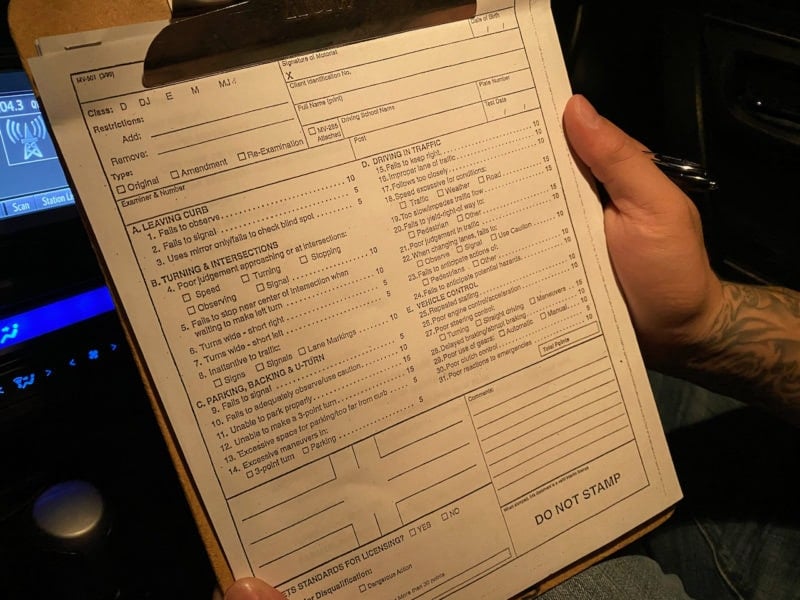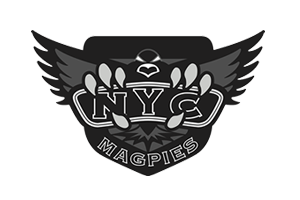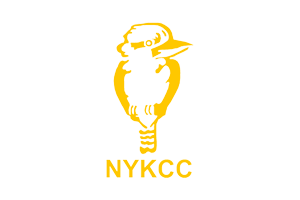I've been driving for over 16 years, so when it came to taking a driving test all over again, I was (safe to say) terrified. I've broken down all the steps you need to pass the test, and explained what they're looking for at each spot. With this, you're sure to pass!
I took my test and went through the whole process of getting my learners permit, but keep in mind that I'm not actually a professional driver or instructor, or attached to the courses I mention below. Everyone's experience might be slightly different!
It's also important to note that even if you have a valid foreign license, you can't just keep driving around on that one, once you become a resident of the state you live in. Confused? I've written all about it here, don't worry.
Things you need before you take the driving test
Well, first, you need to do the full written test in New York. I've written this whole process up here, with some tips and tricks for passing the written test on your first shot!
Secondly, you need to sit through the 5-hour driver training course, and yes, it's not a fun 5 hours. You do need this certificate in addition to your learner's permit in order to sit the driving test though.
Once you hold both these things, you can move to the next step!
Planning before you do the test
Most importantly, I would recommend taking the planning stage of getting your license a tiny bit seriously.
Long story short, the test isn't hard, but it's also relatively easy to fail if you aren't paying it the attention it deserves. Driving a car is a privilege and a dangerous one at that, so make sure you've taken the time to brush up on your skills before you head into taking the test.
Where possible, try and log some driving time so that you are familiar with driving on the right-hand side of the road, and understand what signs look like, how traffic flows, and you get comfortable and familiar. Many people rent cars, or get a ZipCar, in order to do this. Just make sure that you are driving legally with your new learner's permit, and ideally with a licensed driver in the car too to cover all your bases.
I would also recommend that you get a lesson before you sit the test. Now, before you say “But I've been driving for years, why would I take a lesson?”, I need you to know that I thought that too. Here's my answer: When I had the lesson, I wasn't being taught how to drive, I was being taught how to pass the test. They're two very different things.
Driving experience generally makes you a better driver, but in this scenario, you are being tested on a particular checklist and many of the items on the checklist aren't related to how “good” a driver you are, but how much you overtly pay attention (more on that below).
My personal recommendation, and who I had a great experience with, DriveRite. They explain it best on their site about foreign drivers (like me):
Foreign drivers that have been on the road for many years in other countries may assume that they are ready to pass the road test in New York. Upon applying for a permit, however, they learn that they must go through the entire process and that can be frustrating. Trust us, going through the process isn’t something bad. Drivers accumulate bad habits over the years, and they may not realize that they can potentially fail the test with maneuvers that they think are okay. Do not risk failing your road exam and taking it more than once; we offer packages with foreign drivers in mind. With a combination of your experience and our expertise, we will help you pass the test on your very first try.
I signed up for the 5-hour course, one lesson, a test, and a car, all as part of the “Brush Up”, “Rush”, and “Super Rush” plans available on their website.
Things to remember during the test
Here is my top list of things to remember to pass the test, that I had somewhat forgotten in my years of driving. Sure, some of them seem obvious, but you should really make a big effort to remember all of them.
First, here's what you're being tested on, and then I've broken it down, below!

You are allowed to lose up to 29 points, with 30 points failing the test.
Broken down, you can see exactly how many points you can lose per violation.
- Leaving Curb – This will happen at least twice (once when you start, and once when you drive off from after your parallel park):
- Fails to observe – 10 points – Don't pull out in front of any traffic!
- Fails to signal – 5 points – Leave your indicator on for a few extra seconds where you can to make sure the instructor sees it
- Uses mirror only/fails to check blind spot – 5 points – Make a huge effort to look over your shoulder and make it super obvious that you're looking. This applies to the whole test too, just keep looking around and make it obvious that you're checking everything.
- Turning & Intersections – There'll be lots of these
- Poor judgment approaching or at an intersection(s?) – 10 points each
- Speed – Keep it slow when you turn
- Turning – Make sure to turn in your lane
- Stopping – Stop well behind the line when you get to an intersection
- Observing – Check for pedestrians, don't take off if there's any traffic
- Signal – Use that indicator!
- Fails to stop near the center of the intersection when waiting to make a left turn – 10 points – When you're turning left, you're meant to roll out into the middle of the intersection, don't stop and wait to enter! Also don't roll over into oncoming traffic before it's free to do so, and aim for the middle, don't over-shoot!
- Turns wide – short right – 5 points – This is referring to a right turn when you want to make sure that you turn into the closest lane possible, and don't cross over the lines to the next lane. This applies if the next lane is oncoming traffic or traffic in the same direction, you must keep in the close lane. If there's an obstruction (e.g. a truck in the way), you're meant to turn into the close lane, then indicate to change lane (follow all the rules for changing lanes), and then change lanes around the obstruction. You can't just swing wide as you would probably do with experience.
- Turns wide – short left – 5 points – Same thing, but turning into a one-way street with possibly multiple lanes, don't drift!
- Inattentive to traffic – 10 points each – These ones, again, seem obvious, but they can happen quickly if you're not overtly showing how attentive you are
- Signs – Don't ignore those signs
- Signals – Traffic lights, other cars, pay attention!
- Lane markings – Don't wander about the street, pay attention to where you're stopping at stop signs, and be aware of when you can and can't change lanes (solid line vs. dashed)
- Poor judgment approaching or at an intersection(s?) – 10 points each
- Parking, backing, and u-turn – This is the one that catches lots of people
- Fails to signal – 5 points – Just make sure you do it, with lots of notice, and leave it on for the count of 3 at least before you start doing anything else
- Fails to adequately observe/use caution – 10 points – When you start the process, be sure to have your head on a swivel and look behind before moving backward. If there is traffic or people, don't go!
- Unable to park properly– 15 points – Golly, this one is a big one, I assume it means that you just really can't do it at all.
For those of you who are a bit scared of the reverse parallel, here's my big tip for passing the parallel park test:- Pull your car up to the one parked in front of your spot, and line up your front mirrors, about 2 feet apart.
- Rotate the wheel 2 full rotations to the right, and then roll backward. You want to get your car to a 45-degree angle with the side of the road, and you'll know you've done this because, in your side mirror on your right, you will see that your door handle is touching the curb (and my teacher explained that you'll see a wedge of street pizza – this makes more sense when you see it).
- When you're at 45, stop.
- Now rotate the wheel back to straight (2 to the left). Now you want to roll back far enough that the front of your car clears the back of the car next to you. This is really the only bit that requires you to use some instinct, but it's not too far. Then stop.
- Now rotate the wheel one rotation to the left, and roll back, this will slowly line your car up with the curb. When you think you're straight, stop.
- Rotate your wheel back to straight (one to the right) and then roll forward a tiny bit.
- You should be perfect.
- Unable to make a 3-point turn – 15 points – Another big one. The three-point turn should really be very easy but a few things to note: Don't do a u-turn, even if you can make it, this fails the 3-point turn. Before going backward, be sure to look and check over your shoulder. And do each step slowly and thoughtfully.
- Excessive space for parking/too far from the curb – 5 points – Ok, here's the biggest tip for passing this test, and I'm going to repeat it below, parking too far away is much better than hitting the curb. Hitting the curb is an instant fail. Even slowly, and even if you just slightly glance it while getting the perfect park nice and close. Don't do it. Sacrifice these 5 points, and park far away from the curb instead. You will pass.
- Excessive maneuvers in – 5 points each –
- 3-point turn – This basically just means that your 3 point turn became a 4 point turn
- Parking – So you needed to slightly adjust yourself after you reverse paralleled? Not a huge sacrifice if you need to do it! Just don't hit the curb!
- Driving in Traffic – This is the bulk of the test!
- Fails to keep right – 10 points – They drive on the right in the USA, so don't go wandering into the left lane. You should make sure of this even when on un-laned roads, and on a one-way single-lane street you should try and aim for the center and maybe SLIGHTLY to the right, but not all the way over.
- Improper lane of traffic – 10 points – Again, drive in the correct lane!
- Follows too closely – 10 points – The tip for this is to make sure that you can always see the wheels of the vehicle in front, even if you're stopped. Never ever get closer than that, and realistically, just give yourself plenty of space for the test, it's only 10 minutes of driving like Nanna.
- Speed excessive for conditions – 15 points each – My driving teacher told me to stick to around 20-25 mph for the whole test. You shouldn't be asked to drive anywhere faster than that, and you want to be well below the speed limit, not right at it.
- Traffic – Lots of traffic? Slow down.
- Weather – Lots of weather? Slow down.
- Road – Road has holes? Slow down.
- Too slow/impedes traffic flow – 15 points – As above, this isn't about driving safely slightly below the speed limit, this is doing 5 mph in traffic. Don't worry too much about this one.
- Fails to yield right-of-way to – 15 points each
- Pedestrian – Don't hit pedestrians, this should be a no-brainer. They ALWAYS have right of way. So if they walk out, even if the rules say they shouldn't have, give them plenty of space and time.
- Other – At a 4-way stop, you must start driving in the order that you arrived, and if two arrive at the same time, give way to your right. If you are driving straight, you generally have right of way over cars turning. If you are at a yield sign, yield. If you're at a stop sign, and the other lanes don't have stop signs, yield.
- Poor judgment in traffic – 10 points – This is really just about making sure you're looking around and you're aware of how traffic is behaving. If you drive safely, you're fine.
- When changing lanes, fails to – 10 points each –
- Observe – Head. On. Swivel.
- Signal – Do it first, and do it for at least a handful of blinks before doing anything else.
- Use caution – Don't turn into other cars, and you should be fine!
- Fails to anticipate actions of – 10 points each – Seems you have to embrace your inner Yoda for this one!
- Pedestrians – Honestly, if you see pedestrians, just give them plenty of space, and plenty of time to completely get out of your way.
- Others – People are crazy, assume they're going to do something crazy, let them do it, and leave lots of space.
- Fails to anticipate potential hazards – 10 points – Again, this seems a little Jedi, but basically, if you see something up ahead, feel free to talk it through with the person testing you. Don't ask for help, but explain what you're doing! e.g. “I can see there's a truck up ahead so I'm just going to slow for it and move around it when safe”. Throughout the test, you won't do much by your own choice because you'll be told to “Turn left, turn right, straight on, park here” so explaining why you're breaking from this can't hurt!
- Vehicle Control
- Repeated stalling – 10 points – If you've stalled your automatic car, then maybe you shouldn't be driving.
- Poor engine control/acceleration – 10 points – The benefit of using a company like DriveRite (above) is that you get to try out their cars in practices before the test. This will mean you get to feel the pedals and how the car reacts. I think you'd have to be constantly jerking along to lose these points, so don't worry at the very beginning
- Poor steering control – 15 points each –
- Turning – Make your turns precise, and use hand over hand to turn.
- Straight driving – Drive. Straight. Keep both hands on the wheel at all times at 10 and 2. This one is easy to forget if you've been driving for a while!
- Maneuvers – Again, make them clear, defined, and without wobbly bits.
- Delayed braking/abrupt braking – 10 points – Brake slowly and evenly wherever possible. If you're approaching an intersection, coast and slowly brake, don't give your instructor a chance to use their brake because that will fail you immediately.
- Poor use of gears – 10 points – If you're failing this in an automatic, well, I don't know what you're doing.
- Poor clutch control – 5 points – Again, stop going for the clutch, it's an auto
- Poor reactions to emergencies – 10 points – You'd have to be really unlucky to get this one, but do be sure to look out for emergency vehicles and pull over safely if you can get out of their way. Don't obstruct them or you'll fail right away.
The number one thing to remember when doing the NY driving test (especially if you're an experienced driver)
You will instantly fail the test if you hit the curb doing your reverse parallel park.
Don't hit the curb.
Lose 5 or 10 points by putting yourself much further away from the curb instead.
This will pass the test (easily) and even if it feels weird to be 2 feet away from the curb, you'll be happy not to have to sit the test again.













Thank you for this explanation and elaboration
Story from an American living in New South Wales… First, I was amazed all I had to do was hand over some cash and show my American drivers license to get one in Australia. After some years, I decided to go back to California to work, and my California drivers license had expired. There was more than one reason for me to renew my California license, even though I wasn’t sure how long I’d be staying. I didn’t have to take the driving test, but I had to take the written test(s). I passed the automobile exam, but failed the separate motorcycle exam. The tricky questions in my mind are numbers – how many feet ahead of a turn are you supposed to signal? But there were some odd motorcycle-specific questions I guessed on. By the time it was graded, the license branch would be closing in about ten minutes. The clerk informed me of the amazing fact that you were allowed to take the exam THREE TIMES on each visit, but if you failed on the third try, you had to return at a later date. I didn’t have enough time to go back and look through the study guide, but the clerk was willing to hand me a new exam to give it another go. Knowing which questions I missed, I was able to figure out the better answers, passed, and didn’t have to return on another day. As an aside… I originally obtained my drivers license in another state where driver’s training was a summer option for high school students. In that state, at that time, there was no separate exam for motorcycles. If I remember correctly, you just paid an extra fee. Later, having that privilege on my license allowed me to avoid having to take a motorcycle training course in California. When I was in the military, there were so many motorcycle injuries and fatalities that the military started its own motorcycle riding course and made it mandatory for those riding motorcycles.
Great! If I’m ever brave enough to take the test again, I’ll fail again because they won’t let me park away from the curb and then I’ll fail by hitting it. I know I’m a good driver, but I hit the damn curb and I can’t do a parell (which is fucking pointless anyway) to save my soul.
Thank you!
hi im 16 and aking my rode test tom am i gonna be able to drive alone or i have to wait till im 17?